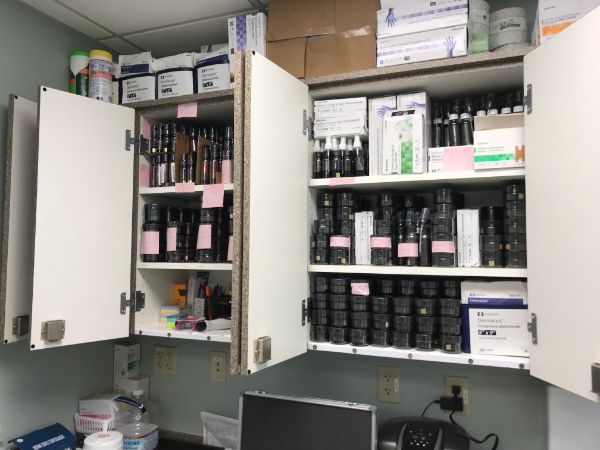
Team Leader: Eric Miller
Team Type: Pain Reduction in the Tattoo Removal Process for Incarcerated Youth
Campaign Summary: Capitol City Medical Teams accepted approximately $15,000 of lidocaine and donated it to the Oregon Youth Authority to aid in the removal of tattoos on incarcerated youth
Supporters:
Pain Relief Naturally — Salem, Oregon
Oregon Youth Authority — Salem, Oregon
Narrative: By Eric Miller
Every once in a while something comes “across the desk” of Capitol Medical Teams that doesn’t involve supporting a medical team overseas or some other international health project. However, the project still fits within its mission statement.
For example, in December 2020 Capitol City Medical Teams received a phone call from Bert James of the company Pain Relief Naturally based in Salem, Oregon. Mr. James shared that his company was discontinuing their line of lidocaine products that were normally sold to tattoo parlors to relieve pain in people who have just received tattoos. Yes, getting a tattoo can be painful. (Lidocaine is a topical – often being applied to skin – pain reliever.)
I asked how much product are we talking about? Bert replied six boxes. Not knowing exactly what I was going to do with six boxes of lidocaine spray, gels, and creams, I agreed to accept the donation. A few days later, Bert delivered the boxes. They were larger than I had anticipated and I asked Bert what their value would be if they sold it to their customers. He replied around $15,000. Wow!
I originally thought the lidocaine could be sent to the Kausay Wasi Clinic, but the sheer number of containers and volume of product didn’t make it financially viable to be shipped there. Perhaps it could be delivered in suitcases along with the medical supplies of our supported teams. Covid then struck and Capitol City Medical Teams hadn’t supported a medical team’s campaign in a while and it didn’t seem like one would be supported in the near future. So I made a few a few calls to see if any organization was interested in the lidocaine, but none were. Well, I thought I could always dispose of it.
About that some time my wife, Dr. Kim Geelan, M.D., got involved with the Oregon Youth Authority’s program to remove tattoos from incarcerated youth. If tattoos were painful to get, then they might also be painful to remove. It turns out they can be painful to remove and that multiple treatments are needed to remove most tattoos. Dr. Geelan said I should contact Javier Perfecto of the Office of Inclusion and Intercultural Relations for the Oregon Youth Authority to see if he was interested in accepting the product. He said he was. After the needed approvals were granted, the Oregon Youth Authority’s Maclaren’s Youth Correctional Facility accepted the lidocaine and it’s being used to reduce the pain involved in tattoo removal on youth who want their tattoos removed.
It’s ironic that the products’ original intent was to help relieve pain in the tattoo application process, but it is now being used in the tattoo removal process.
MORE INFORMATION ABOUT TATTOOS AND THEIR REMOVAL
The information below has been quoted and adapted from:
https://www.webmd.com/skin-problems-and-treatments/laser-tattoo-removal
The WebMD content was medically reviewed by Stephanie S. Gardner, M.D. on March 09, 2021
Nearly 30% of people in the U.S. have at least one tattoo. Almost half of all millennials have one. But not all of them are happy about their decision. As many as 25% of those with a tattoo say they regret getting it. If you’re in that 25%, there is good news. Laser tattoo removal techniques can significantly diminish the appearance of your unwanted tattoo with minimal side effects.
How Tattoo Removal Works
Lasers remove tattoos by breaking up the pigment colors with a high-intensity light beam. Black tattoo pigment absorbs all laser wavelengths, making it the easiest color to treat. Other colors can only be treated by selected lasers based upon the pigment color. Once sufficiently small, the broken up pigments are picked up by white blood cells and transported to the liver for processing and removal.
The number of treatments needed will depend on the age, size, and color(s) of the tattoo. The color of your skin, as well as how deep the tattoo pigment goes, will also affect the removal technique.
The Tattoo Removal Process
In general, this is what you should expect during a laser tattoo removal session: You’ll be given a pair of protective eye shields. The technician will test your skin’s reaction to the laser to determine the most effective energy for treatment. The technician uses the laser to pass pulses of intense light through the top layers of your skin that will be absorbed by the tattoo pigment only. Smaller tattoos will require fewer pulses while larger ones will need more to remove them. In either case, to completely get rid of a tattoo, it will take several treatments. After each visit, your tattoo should become progressively lighter.
Laser tattoo removal is uncomfortable, but most patients don’t need anesthesia. Depending on the location of the tattoo, you may want to apply a topical anesthesia cream beforehand. Immediately following the treatment, use an ice pack to soothe the treated area. And apply an antibiotic cream or ointment and bandage to protect it. You should also be sure it’s covered with sunblock when outside.






